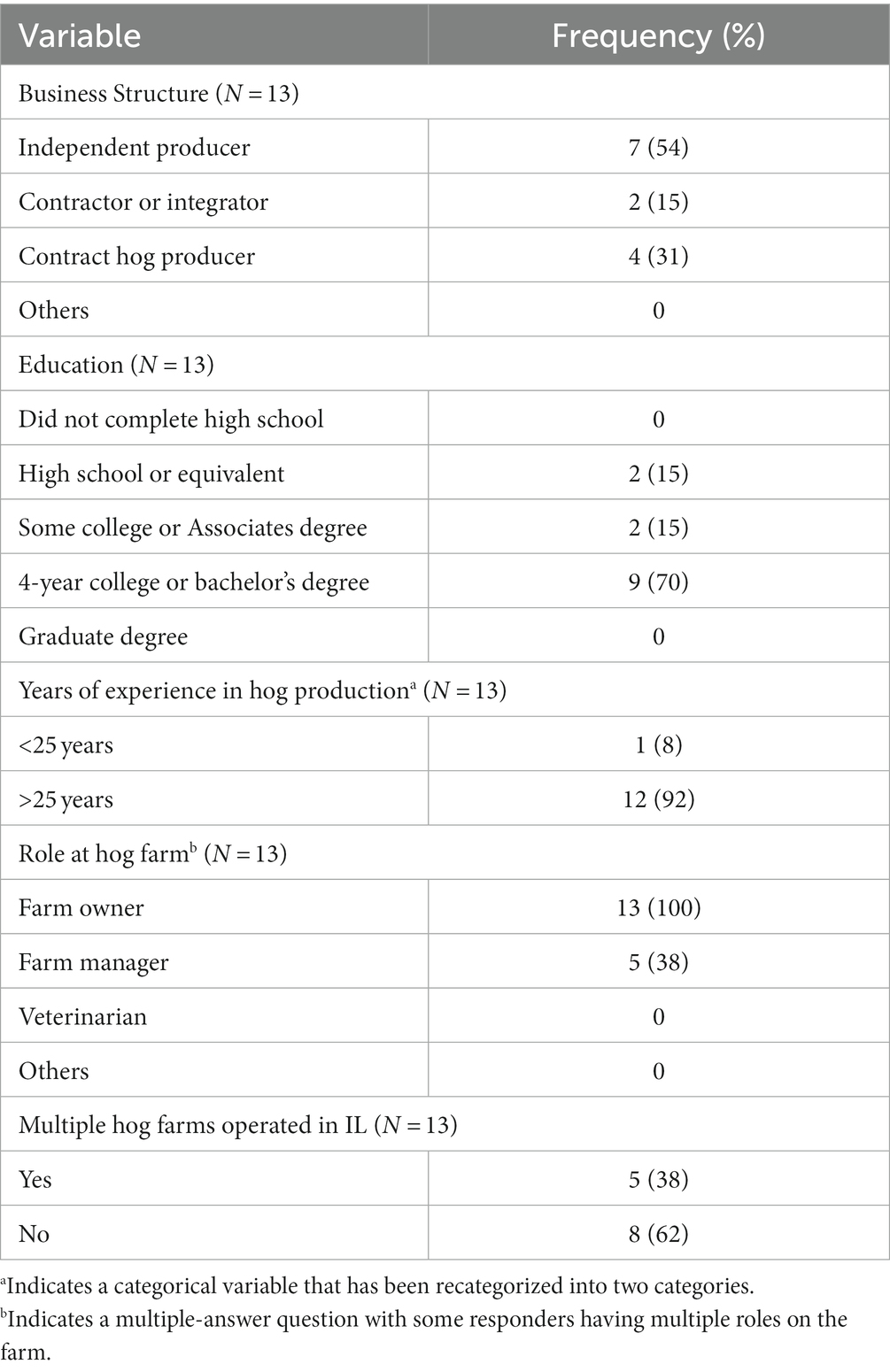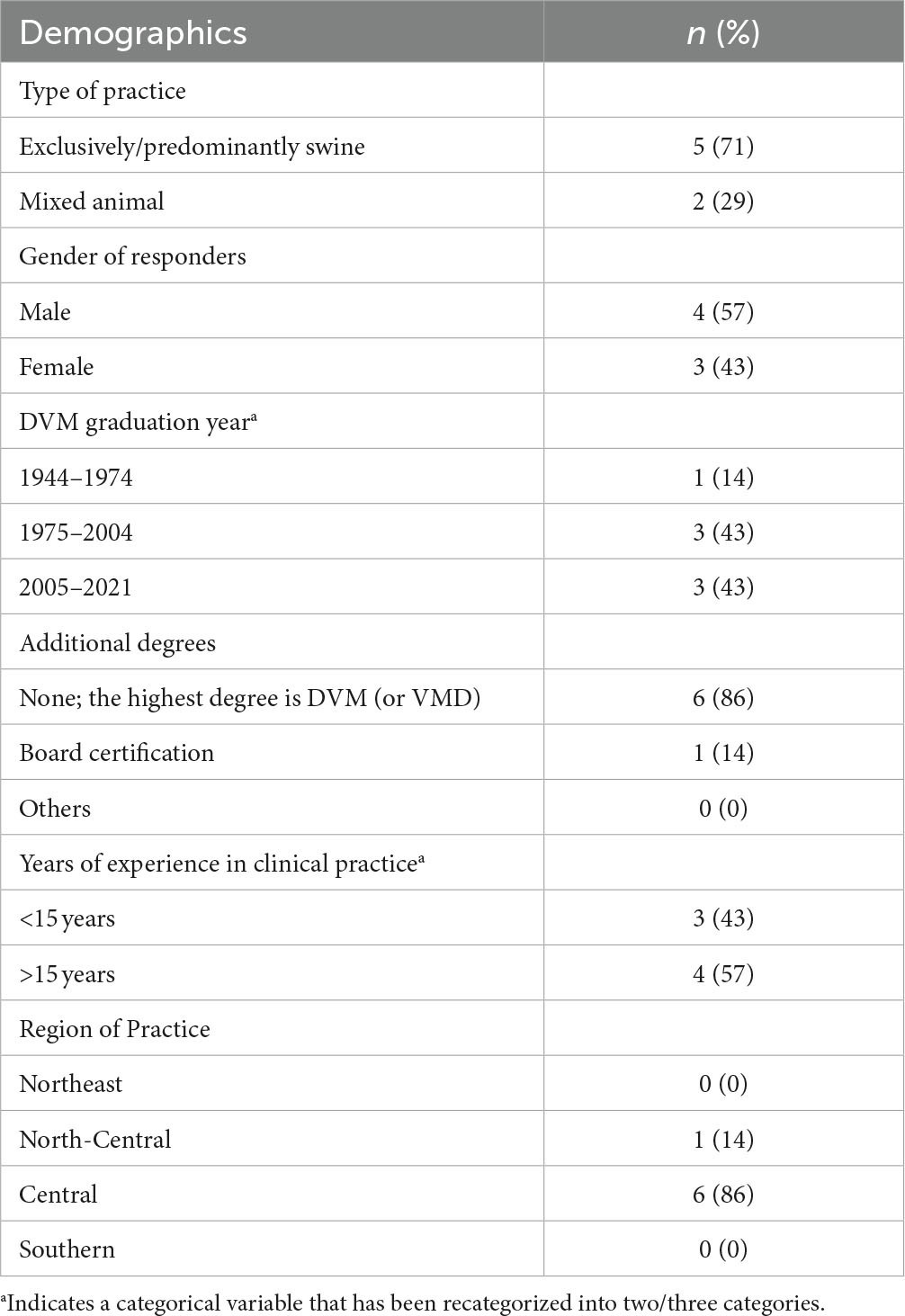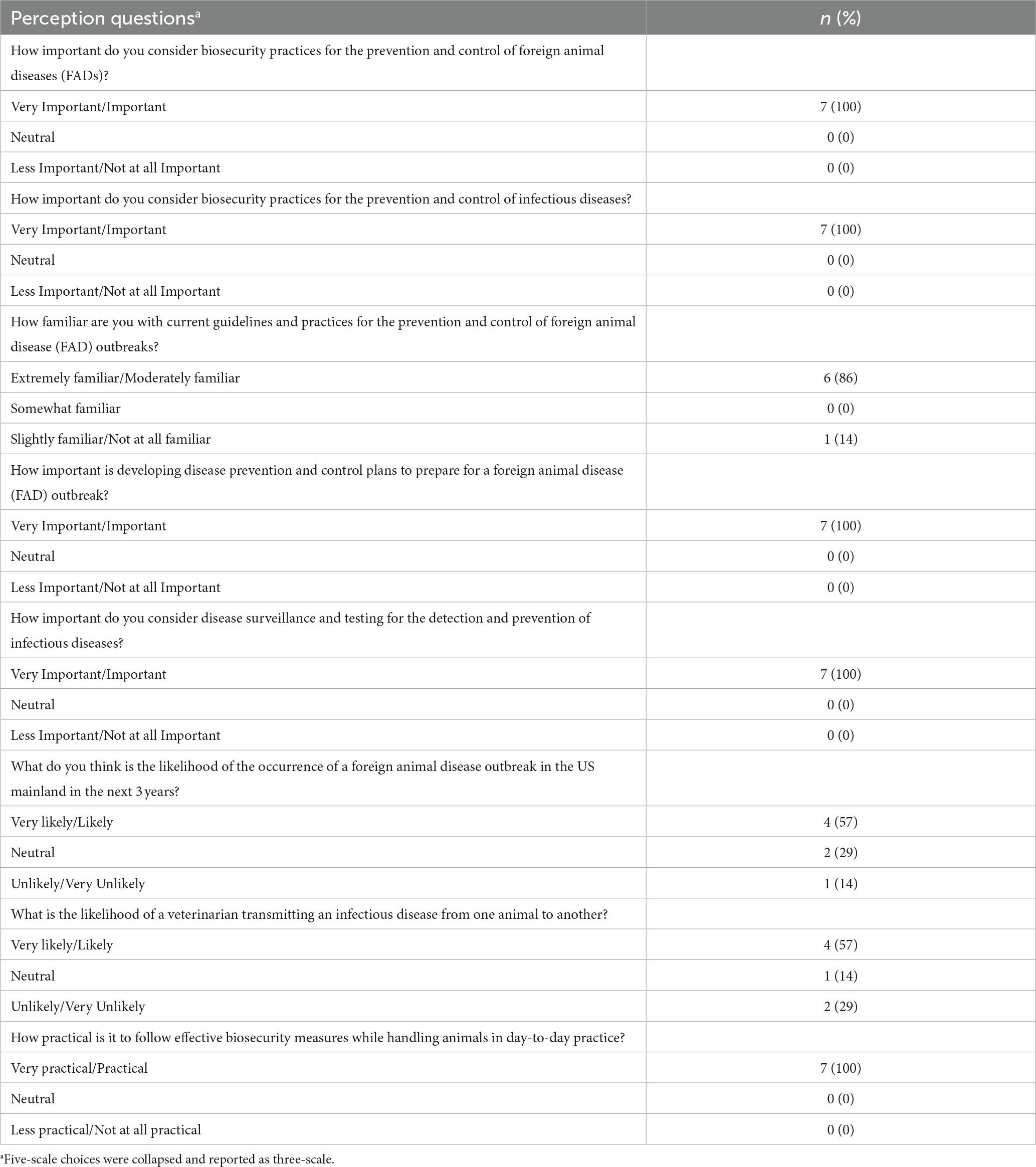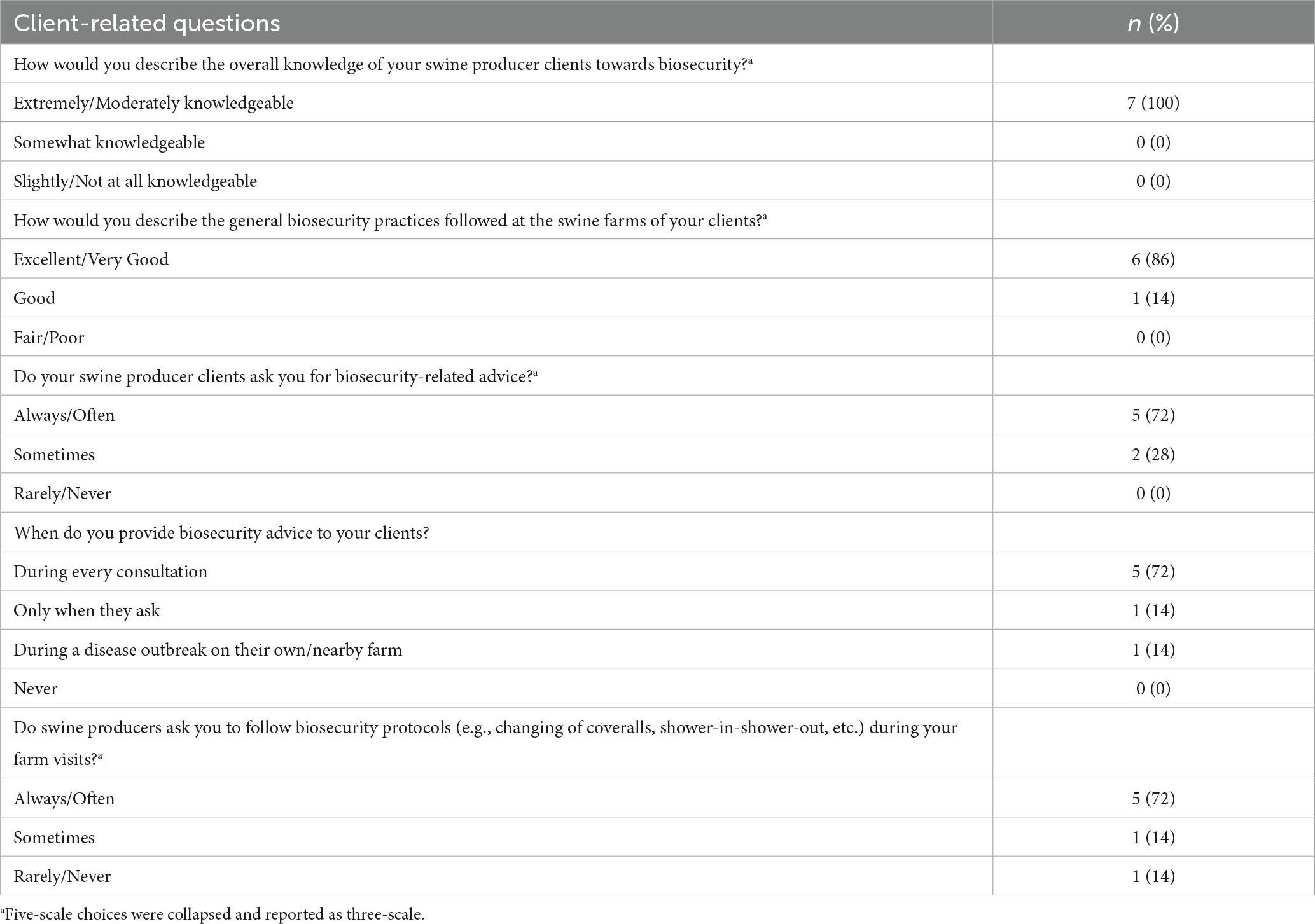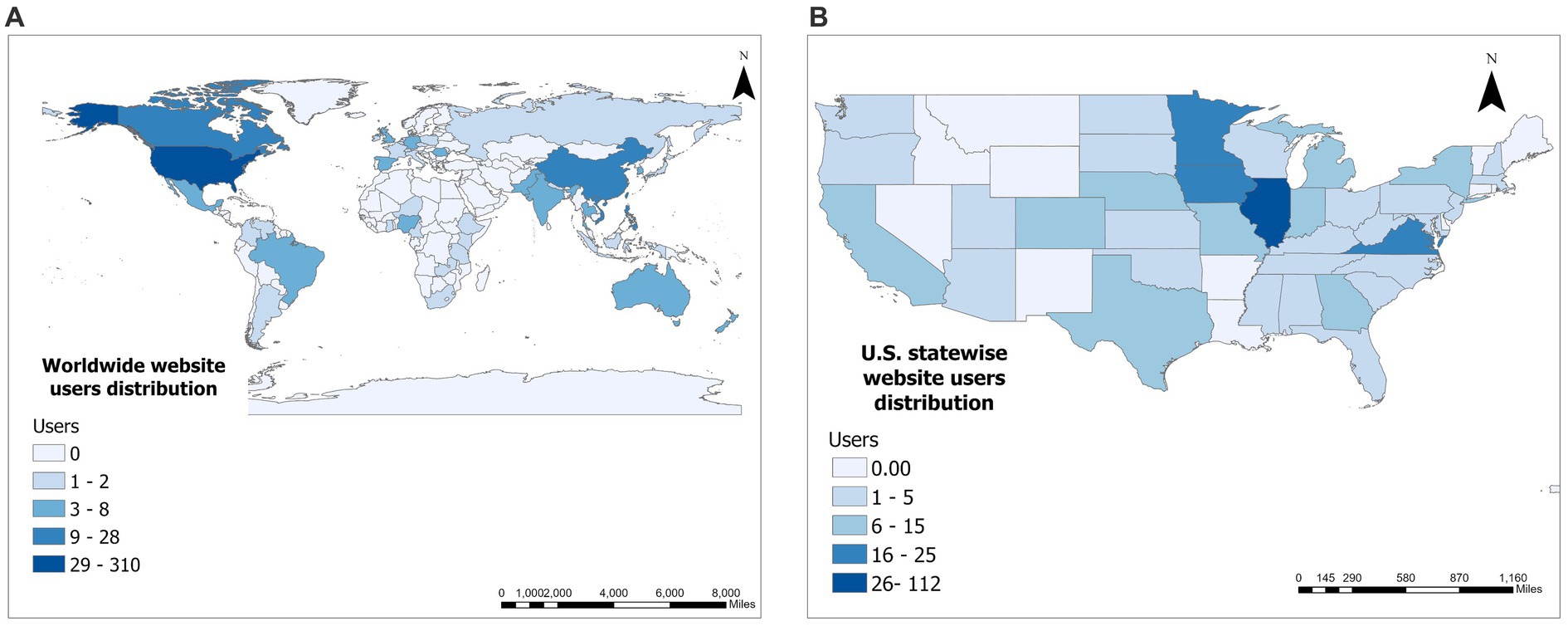- 1Department of Pathobiology, College of Veterinary Medicine, University of Illinois Urbana-Champaign, Urbana, IL, United States
- 2Agriculture and Environment Extension, College of Agriculture, Food, and Natural Resources, University of Missouri, Columbia, MO, United States
- 3Carl R. Woese Institute for Genomic Biology, University of Illinois Urbana-Champaign, Urbana, IL, United States
There is a growing risk to the health and productivity of the Illinois and United States swine population from foreign and endemic infectious diseases. Effective on-farm biosecurity practices play a pivotal role in preventing these high-consequence pathogens from affecting swine farms. Veterinarians are essential in providing disease prevention advice to swine producers that can help them implement effective biosecurity practices on their farms. Our descriptive study objectives were to assess Illinois swine producers’ and veterinarians’ biosecurity perception, knowledge, and practices to identify knowledge gaps and address these by developing an online educational website. We developed two independent online questionnaires using QualtricsXM software. Swine producer members of the Illinois Pork Producers Association and veterinarians registered with the Illinois State Veterinary Medical Association were contacted via e-mail through their associations and asked to complete an online survey. In total, 13 swine producers across 9 Illinois counties operating 82 farms (8 managed single farms and 5 managed multiple farms) responded to the swine producer survey. Despite some biosecurity awareness among swine producers, the need for a biosecurity-related outreach program was evident. Among the 7 swine veterinarian responders, 5 predominantly treated swine (oversaw an average of 21.6 farms), and 2 were mixed animal practitioners. The swine veterinarian survey showed a disconnect between their biosecurity perception and practices. We developed a biosecurity educational website and used Google Analytics to collect website traffic and user data. The 4 months of data showed good coverage that included the highest proportion of users from the Midwest and North Carolina, the largest swine-production regions in the US, and China and Canada, the leading producers of swine worldwide. The most accessed webpage was the resources page, and the swine diseases page had the highest engagement time. Our study highlights the effectiveness of combining online surveys with an educational website to assess and improve the biosecurity knowledge of swine producers and veterinarians that can be applied to assess and improve the biosecurity knowledge and practices of other livestock farmers.
1. Introduction
The United States of America (US) is a leading producer of pork and pork products (1). The entry and spread of pathogens causing foreign animal diseases into and among the US swine farms and the emergence of endemic infectious diseases would threaten the productivity and profitability of the swine sector and would negatively impact the agricultural economy (2, 3). On-farm biosecurity knowledge, plans, and associated practices are crucial to prevent the introduction and spread of these high-consequence pathogens into swine farms (2, 3).
Pork production is a vital component of the US agricultural economy, contributing to an estimated $35.86 billion of personal income and $57.20 billion of the gross national product in 2021 (4). Within the US, the Midwestern states (Iowa, Minnesota, Indiana, Illinois, Missouri) and North Carolina are leaders in pork production. Illinois ranks fourth with an annual output of $1.91 billion of marketed hogs and 5.4 million heads in December 2021 (5). The US swine industry has changed significantly in the last few decades, shifting from a small-scale swine production system of numerous farms, each with fewer pigs, to an integrated system of fewer farms with a large number of pigs (6). In Illinois, larger farms with 5,000 or more hogs are predominant, making up 76% of the total swine inventory, while farms with 2,000 to 4,999 heads represent 18%, and farms with less than 2,000 heads constitute only 6% (7). The integrated multi-site swine production system requires more within and between farm movements of animals and people, posing new challenges in maintaining disease-free farms (8–10). Moreover, the emergence and re-emergence of infectious and economically devastating swine diseases in the US, like Porcine Reproductive and Respiratory Syndrome (PRRS) (11), Porcine Epidemic Diarrhea (PED) (12), and the looming threat of African swine fever (ASF) (13), adds to the risks to the US swine industry. Some of these diseases can be prevented or controlled by vaccination; however, in the US, there is no commercially available vaccine or treatment against foreign animal diseases like ASF (14). The gravity of the consequences of these disease outbreaks in the US highlights the importance of protecting the swine herds by adopting disease prevention practices.
The “minimal disease approach” theory, which aims to produce healthy pigs economically, first described biosecurity in swine production around the 1980s (15). The concept of on-farm biosecurity categorizes these procedures into two components: external biosecurity, which consists of measures aimed at preventing the introduction of a disease into a farm, and internal biosecurity, which involves practices intended at controlling the spread of already present diseases within a farm (3). Previous studies described the importance of biosecurity in disease prevention and control and highlighted the benefits of adopting effective biosecurity plans and practices for swine producers (2, 3, 16–20). However, a lack of knowledge about these practices feeds the resistance to their adoption. Therefore, to encourage the adoption of biosecurity plans and practices, it is essential to understand the perception and beliefs of swine producers (21), as the Theory of Planned Behavior suggests that human behaviors and practices are belief-driven (21–23).
Livestock veterinarians play a crucial role in ensuring animal health and welfare by treating farm animals, addressing producers’ concerns on health management, advising farmers on disease prevention, and assessing the effectiveness of on-farm biosecurity practices (3, 24). Effective on-farm biosecurity requires continuous assessment and improvements of plan and practice that requires a veterinarian’s recommendations and expertise (25). Previous studies have shown the significance of educating farmers on effective disease prevention and control practices for maintaining farm biosecurity (17). Moreover, educating swine producers on diseases and biosecurity measures is vital for shaping a positive perspective toward biosecurity (16, 18).
Using a web-based platform as an educational tool deems fit in this age of digitalization, where access to the Internet has become imperative for a diverse set of industries, including agriculture and livestock production (26, 27). An educational website provides opportunities for educators to evaluate, improve, and update the provided information over time based on the users’ needs (28). Adding Google Analytics to these web-based education tools is a cost-effective way of assessing the effectiveness of user engagement and website outreach (29) Google Analytics is a valuable tool that enables user data collection and website traffic monitoring and is a free hosted service that uses JavaScript to collect data (30). Previous studies have used Google Analytics to collect website traffic data to evaluate the effectiveness of their website and enhance the web-based learning experience for their users (31, 32). Website traffic data gives information on the most and the least visited pages, the number of downloads, and the time spent per page. In addition, Google Analytics records information on users’ demographics, geographic locations, and devices used to access the website (31, 32).
Encouraging swine producers to adopt farm-level biosecurity plans and practices and their continuous evaluation is an ongoing challenge (3). There is a lack of literature on disease risk perception, foreign animal disease preparedness, and biosecurity knowledge of swine producers and veterinarians in Illinois and the US. No previous study has evaluated Illinois swine producers and veterinarians on their biosecurity knowledge and perception. As a leading pork-producing state, evaluating Illinois swine farmers’ and veterinarians’ biosecurity practices and understanding their infectious disease risk perception is imperative. With this aim, the first study objective is to assess Illinois swine producers for their knowledge and perceived risk of foreign and endemic diseases, evaluate biosecurity practices implemented on their hog farms, and assess their preparedness for a potential foreign animal disease outbreak. Given the significance of swine veterinarians in swine health management, the second objective of our study is to evaluate swine veterinarians’ biosecurity knowledge, perception, and practices and explore their relationship with their swine producer clientele. The third study objective is to develop an online biosecurity educational website to address the knowledge gaps identified during the surveys and evaluate the effectiveness of the biosecurity website as an educational tool.
2. Methods
The survey design and administration protocols followed for swine producers’ and veterinarians’ surveys are described in Figure 1.
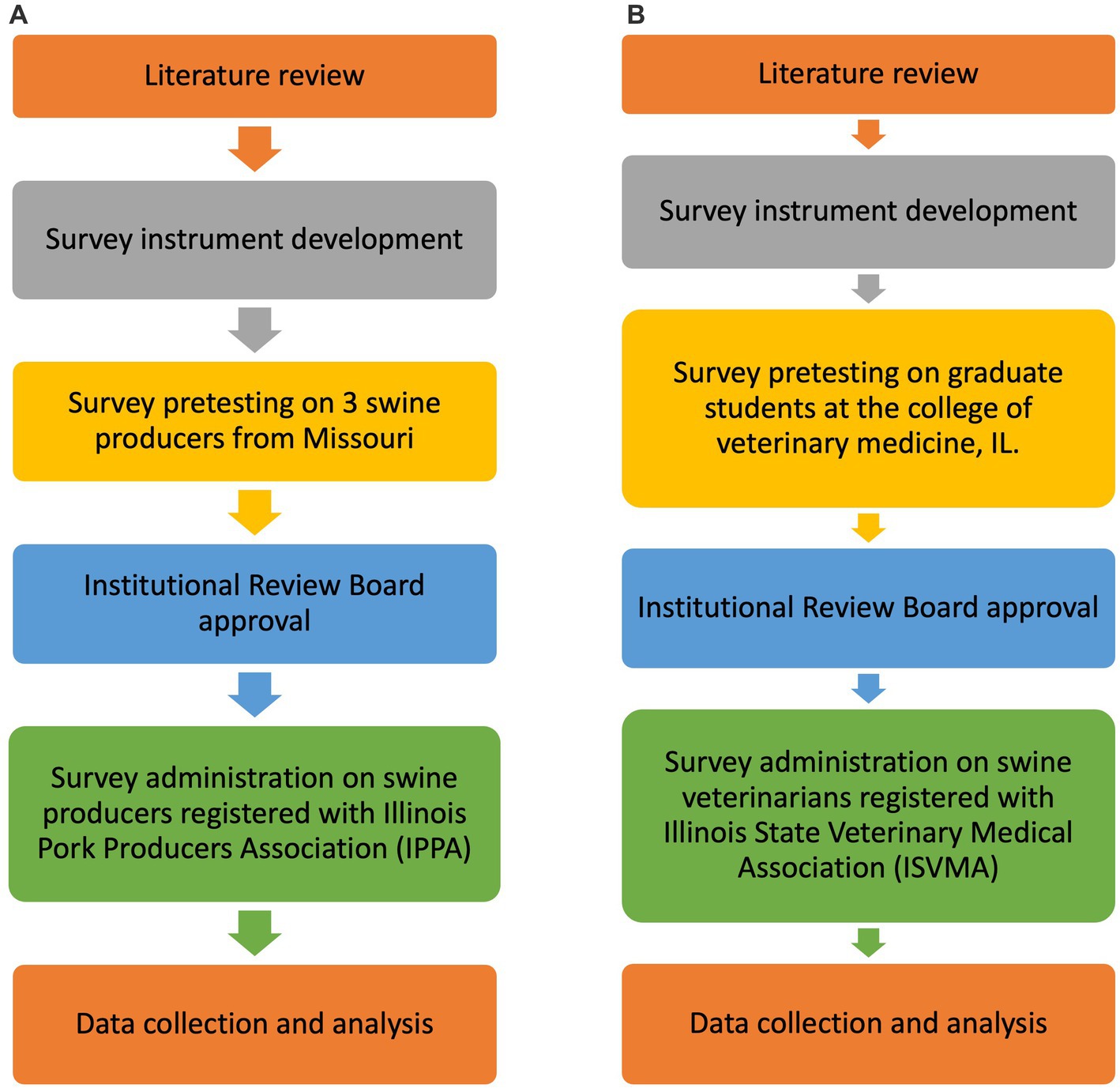
Figure 1. Description of the design, administration, and analysis of the swine producer (A) and swine veterinarian (B) surveys.
2.1. Ethics statement
The Institutional Review Board (IRB) of the University of Illinois at Urbana Champaign approved the survey instruments and the study procedure for the swine producers and swine veterinarians surveys (IRB #21974). We complied with the set guidelines for the study methodology and data collection. The surveys received an exempt status because participants remained anonymous and they had to complete a consent form at the beginning as a prerequisite to participate in the survey.
2.2. Survey of swine producers
2.2.1. Sampling frame, questionnaire development, and pretesting
The sampling frame consisted of swine producers registered with the Illinois Pork Producers Association (IPPA).
The study team developed the questionnaire consulting existing literature on biosecurity practices and evaluation (2, 18, 33–38) and by seeking advice from experts in swine biosecurity and survey research methodology from Illinois. Additionally, two board members from the IPPA reviewed the questionnaire and provided feedback. Lastly, three swine producers from the state of Missouri pretested the questionnaire. Pretesting enabled us to check the survey flow and identify potential problems in the survey instrument and its relevance to swine production in Illinois. Based on the comments received from the experts and swine industry stakeholders, the study team modified and finalized the questionnaire.
2.2.2. Questionnaire characteristics and survey administration
We designed a concise and interactive survey that took the responders approximately 15 min to complete. The number of questions in the survey ranged from 98 to 116, depending on the answer choice of the swine producers. Questions not relevant to the responders were skipped using the skip logic attribute of QualtricsXM software. The questionnaire comprised a combination of closed and open-ended questions divided into nine sections (Supplementary File 1). The sections were as follows: (i) demographics characteristics and general production-related questions (11 questions), (ii) disease risk perception and biosecurity knowledge (10 questions), (iii) farm characteristics tailored to single or multiple farm owners (17–20 questions), (iv) farm practices related to the movement of people (36 questions), (v) farm practices related to the movement of animals (13 questions), (vi) animal health management (6 questions), (vii) previous disease outbreak on their farms (3 questions), (viii) a section for multiple farm owners regarding farm characteristics of their other farms (15 questions), and (ix) a feedback section to learn about the preferred source of disease prevention information of the farmers (2 questions).
The questionnaire was forked based on the number of farms swine producers owned. Farmers who owned multiple farms in Illinois would first respond to the survey questions about their newest farm, and these responders would complete an additional section about their other farms. We developed this section to identify differences in biosecurity-related structures, farm management, and disease history among their newest and other farms. We used the selective display attributes of Qualtrics software to facilitate easy forking based on survey participants’ responses.
The survey was distributed via a personal e-mail through the IPPA in June 2021 to 406 registered IPPA members whose e-mail addresses were available. We enclosed the e-mail with a cover letter that contained the survey link. An e-mail reminder was sent 2 weeks after the initial survey launch. We kept the survey link active for 4 weeks.
2.3. Survey of swine veterinarians
2.3.1. Sampling frame, questionnaire development, and pretesting
The sampling frame consisted of all veterinarians registered with the Illinois State Veterinary Medical Association (ISVMA).
The study team developed the first draft of the questionnaire consulting previous studies (24, 36, 37, 39–42). A veterinarian expert in swine biosecurity in Illinois reviewed the questionnaire. We completed the questionnaire pretesting with 24 graduate students from the College of Veterinary Medicine, University of Illinois, Urbana-Champaign. Most of the graduate students who enrolled in pretesting had a veterinary degree. They checked the survey instrument for validity and errors in survey flow. The questionnaire was revised based on the comments received.
2.3.2. Questionnaire design and survey administration
We designed a short, interactive survey that took approximately 10 min to complete. The survey comprised 45 to 47 closed and open-ended questions divided into six sections (Supplementary File 2). The range of questions in the questionnaire (43–45) implied the use of the skip logic attribute of QualtricsXM to skip questions that were not relevant to the respondent based on his/her answer choices in the previous questions. The six sections in the questionnaire were as follows: (i) general demographic characteristics (7 questions), (ii) disease risk perception and knowledge (10 questions), (iii) disease investigation and reporting (3 questions), (iv) demographics of clinical veterinarians (5 questions), (v) biosecurity practices of clinical veterinarians tailored to their type of practice (18–20 questions), and (vi) sources of updated biosecurity information (2 questions). The questionnaire was forked based on the type of practice using the Qualtrics software’s selective display features. In addition, we included practice-related questions tailored to the practice type (companion animal veterinarian, swine veterinarian, bovine veterinarian, equine veterinarian, and mixed animal veterinarian) for the veterinarians in clinical practice.
In September 2021, ISVMA distributed the survey to all active ISVMA members (1,391 veterinarians) via personal e-mails. The survey was kept open for 8 weeks. During these 8 weeks, ISVMA sent out two personal e-mail reminders and shared the survey link twice in their weekly online newsletter. At the end of the survey, we received 121 responses. For this study, we included only veterinarians exclusively or predominantly working in swine clinical practice (n = 7 swine veterinarians).
2.4. Swine biosecurity educational website development
We designed a swine biosecurity website (14) as an educational tool to address the biosecurity knowledge and practice gaps among Illinois swine producers and veterinarians identified in the surveys. The website contains information on swine diseases and on-farm biosecurity, divided into six modules. The modules covered the following topics: (i) high-consequence swine diseases, (ii) a brief overview of biosecurity, (iii) a description of general biosecurity practices, (iv) a description of external biosecurity, (v) elements of internal biosecurity, and (vi) details of the Secure Pork Supply Plan. An editor translated each module’s content into simple language devoid of jargon. At the end of each module, we included a short quiz to allow the users to “Test their Knowledge” (Supplementary File 3). A consent form was attached with each quiz to request permission from the users to use their quiz result data in an anonymous form for research. Additionally, we created a resources section on the website with useful biosecurity information sheets, including seven Infographics (Supplementary File 4) and seven usable signs in a downloadable format.
2.4.1. Launching Google analytics to track the swine biosecurity website
We set up Google Analytics for the swine biosecurity website to collect website traffic and user data to evaluate the biosecurity outreach and its efficacy as an educational tool. We recorded numerous variables related to website acquisition and engagement, user demographics, and technology used. For this study, we evaluated 4 months of data starting from July 5th, 2022, the day of the website launch and promotion, till November 5th, 2022.
2.5. Statistical analysis
At the end of both surveys, we exported the data from QualtricsXM to Excel (.xlsx) and comma-separated values (.csv) formats. We stored the raw data in CSV format in cloud storage and used duplicate Excel files for data cleaning and recoding. We used STATA Intercooled software (Version 17, Stata Corporation, College Station, TX) for data analysis and R Studio (Version 1.4.1106 2009–2021 RStudio, PBC) for data visualization using packages ggplot2 and tidyverse. We generated descriptive data for all variables and presented them in tables and charts. We calculated the mean for continuous variables and proportions for binomial and categorical variables. In addition, we recategorized the 5-scale Likert scale into 3-scale Likert scale variables, and proportions were reported. Finally, we reported the frequency and proportion of perceptions and practices of swine producers owning single and multiple farms. We generated only descriptive data from the veterinarians’ survey reporting frequency and proportion for all variables.
3. Results
3.1. Survey of swine producers
We received 16 responses from Illinois swine producers, and 13 producers who completed the survey were included in the analysis.
3.1.1. Demographics of swine producers
All 13 responders were male, with a mean age of 57 years. Ninety-two percent of the producers had more than 25 years of experience in swine production (Table 1). Nine of the responders reported having a 4 year college or bachelor’s degree (Table 1).
Sixty-two percent (n = 8) of the swine producers operated a single swine farm, and the remaining (5 producers) operated 74 farms across Illinois. Thirteen producers who completed the survey managed 82 farms from 9 counties across Illinois (Knox, Carroll, Ford, Montgomery, DeKalb, Monroe, Randolph, Effingham, and Lee). The predominant production type of farms was wean-to-finish (n = 66), followed by farrow-to-finish (n = 3), and farrow-to-wean (n = 3). Sixty-two percent (n = 8) of the responders raised only swine on their farm; five producers reported raising other animals along with swine (cattle (n = 2), poultry (n = 2), sheep (n = 1), goat (n = 1), llama (n = 1). All producers reported having a Premise ID on all of their farms, 67 swine farms implemented the Secure Pork Supply plan (46), and seven have had a biosecurity assessment done on their farms within the last 13–24 months. The five multiple farm owners representing 72 swine farms across Illinois reported having “not very different/slightly different” biosecurity plans and practices for the farms other than their newest farm.
3.1.2. Swine producers’ perception of disease risk and biosecurity adoption
Most swine producers believed that biosecurity practices play an essential role in disease prevention and control; however, they had varying perceptions of foreign animal disease risk (Table 2). Four responders representing 62 swine farms in Illinois reported that a foreign animal disease outbreak “probably/definitely will not occur” in the US swine industry in the next 5 years (Table 2). Eighty-eight percent of the responders indicated they would contact a private veterinarian if they suspected an emergency foreign animal disease in their herd (Table 2). Only 33% of the farmers were aware of the government indemnity requirement for a biosecurity plan in case of a foreign animal disease outbreak.
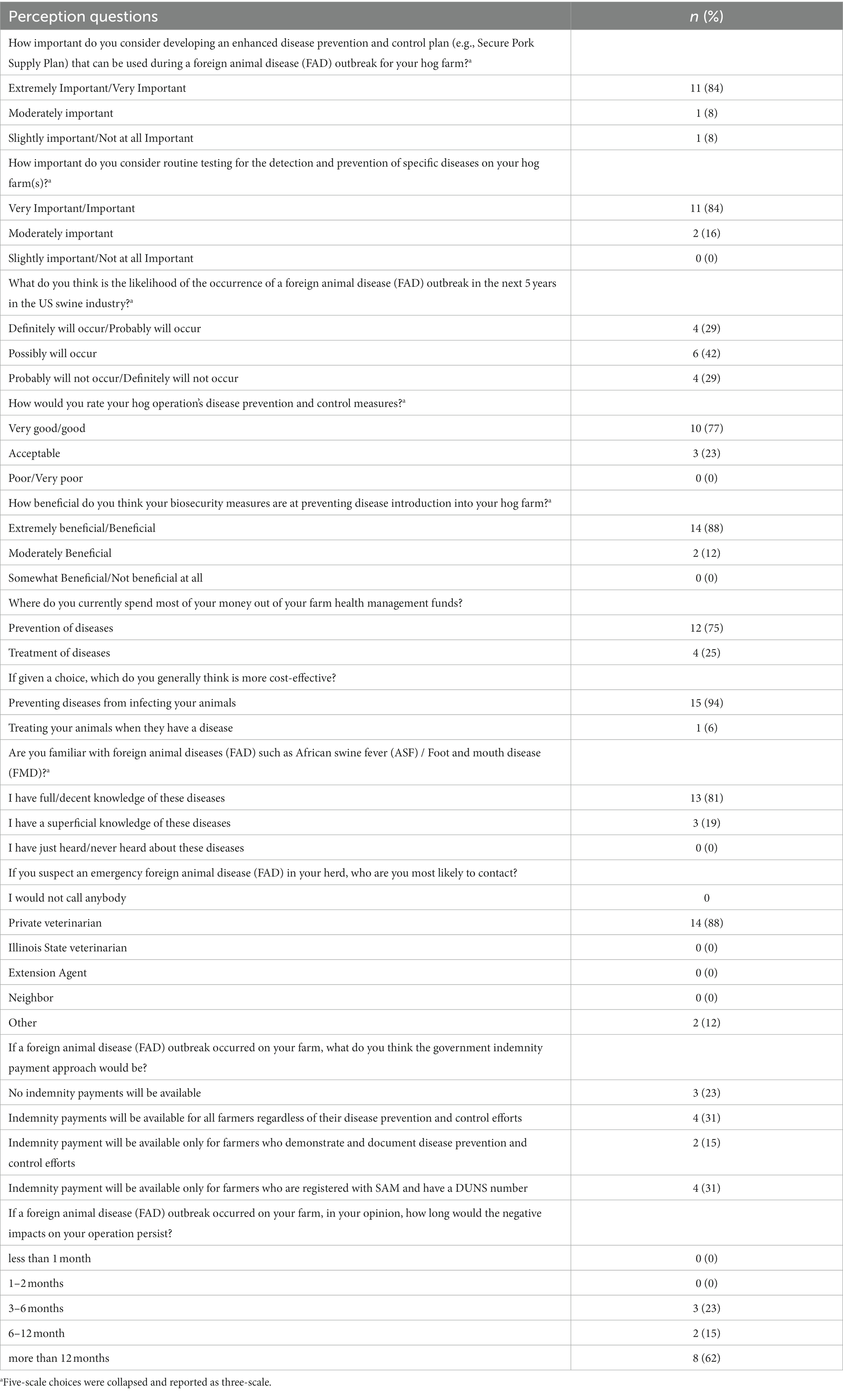
Table 2. Biosecurity and Foreign Animal Disease risk perception-based questions asked to swine producers.
3.1.3. Biosecurity structures of swine farms
More than 85% of the farms had a clear demarcation between dirty and clean areas at the farm entrance. Eighty-two percent (n = 67) of the farms had shower facilities at their farm entrance for shower-in and shower-out for visitors and farm personnel entering the farm (Table 3).

Table 3. Barn-entry system and biosecurity-related structures and practices adopted by swine producers on their farms (N = 82) across Illinois.
3.1.4. Biosecurity practices at swine farms
Responders reported the farm and health management practices followed at their swine farms to maintain farm biosecurity. All 82 farms had active rodent control; however, 74 farms had wildlife exclusion/control facilities, and 73 farms had bird exclusion/control and restricted pet entry on their farms. Eighty-six percent of the producers get feed delivered from the mill, whereas 12% of the producers reported self-production of feed. Seventy-five percent of the responders reported using surface water on their farms, and the remaining producers get well (19%) or public water supply (6%) on their farms. On-site manure storage (n = 78) and land application (n = 78) were the most popular means of manure disposal. Other methods include on-site composting (n = 67) and land application on other farms (n = 70). On-site composting (n = 78) was the primarily reported method of dead stock disposal. Other methods include on-site burial (n = 2), on-site incineration (n = 1), and off-site rendering (n = 3).
The least commonly reported health management practices were testing pigs for diseases and isolating new animals on arrival on the farm (Figure 2). Among biosecurity practices adopted on the farms, restricting vehicles from entering within 10 feet radius of the barn (99%), and requiring the vehicles entering the farm to be washed and disinfected (81%) were most commonly adopted (Table 3).
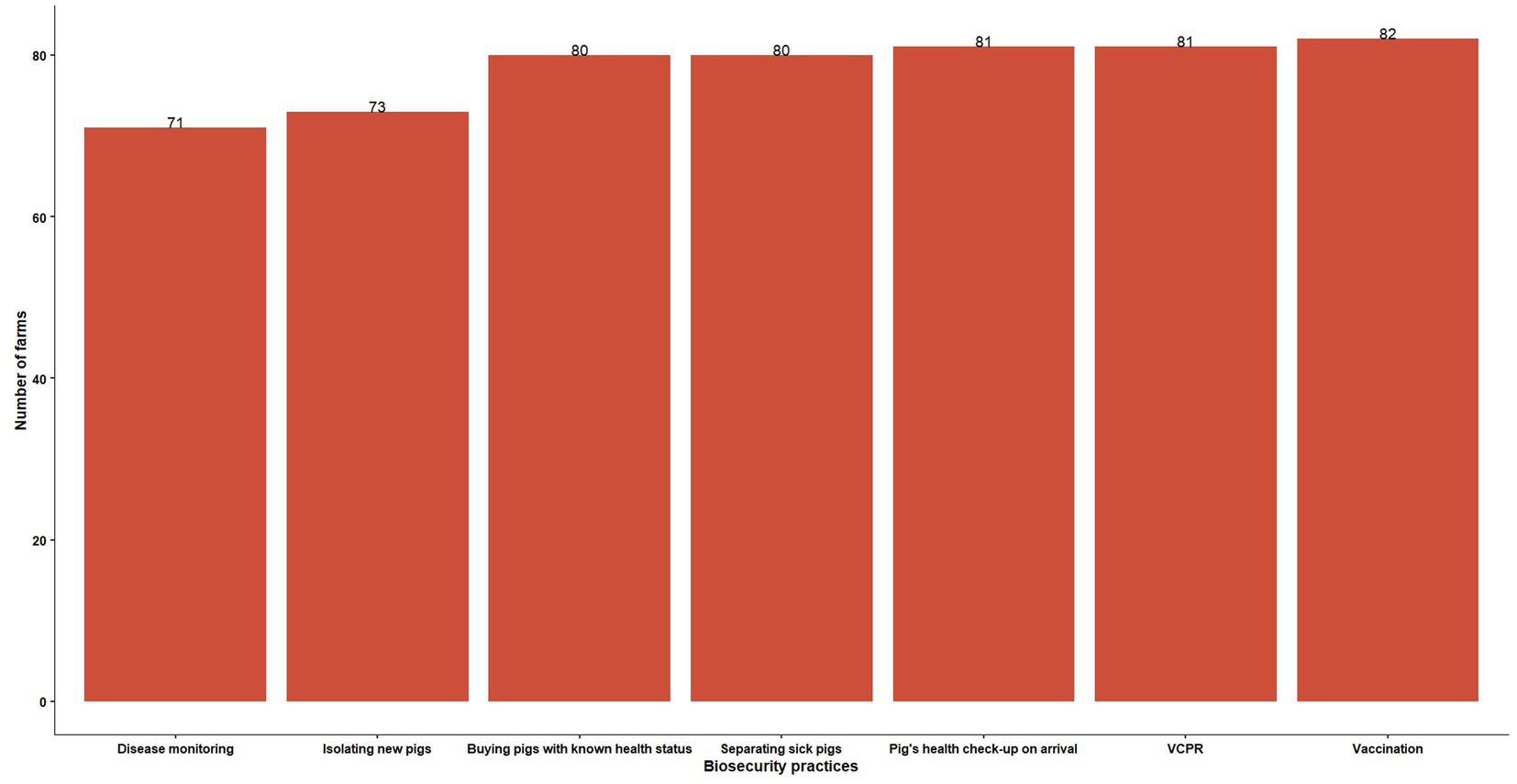
Figure 2. Health management practices adopted on swine farms (VCPR-Veterinarian-Client-Patient-Relationship).
Swine producers reported disease outbreaks on their farms in the last 3 years. Responders (N = 13) reported PRRS (n = 4) and swine influenza (n = 3), as the most common disease outbreak that occurred in the last 3 years on their farms. Apart from this, PED (n = 2), Mycoplasmosis (n = 1), and Seneca Valley Virus (n = 1) outbreaks were also reported by the responders.
3.2. Survey of swine veterinarians
3.2.1. Demographics of swine veterinarians
From the cross-sectional survey of all Illinois veterinarians, responses from 7 swine veterinarians (5-predominantly swine and 2-mixed animals) were included in the study (Table 4). The exclusive swine veterinarians had a mean clientele of 21.6 farms (range: 10–33). Of the seven veterinarians, 4 were males, and 3 were females. One of seven swine veterinarians had board certification. Eighty-six percent of the responders were from central Illinois. Six of seven swine veterinarians were owners of the clinical practice, and one of seven was an associate veterinarian. Fifty-seven percent of the veterinarians had more than 15 years of experience treating swine. Five of seven veterinarians received biosecurity training after completing their veterinarian degree. All these veterinarians received their biosecurity training between the years 2019–2021 through “In-person training” (5 veterinarians),” Continuing Education credits” (n = 2), “webinars” (n = 4), and “phone, printed media, e-mails” (n = 1).
3.2.2. Disease knowledge and risk perception of swine veterinarians
All the responders considered biosecurity practices “Very Important/Important” to prevent and control foreign and infectious animal diseases (Table 5). Eighty-six percent of the swine veterinarians were familiar with the current guidelines and practices for preventing and controlling foreign animal diseases. Fifty-seven percent of responders considered the occurrence of a foreign animal disease outbreak in the US mainland in the next 3 years as “very likely/likely” (Table 5). Two of seven veterinarians considered the likelihood of veterinarians transmitting an infectious disease from one animal to another as “unlikely/very unlikely” (Table 5). All veterinarians thought it was practical to follow effective biosecurity measures while handling animals (Table 5).
Veterinarians were when asked about the most common biosecurity problem in Illinois livestock farms in an open-ended question. The assessment of the open-ended question revealed that veterinarians considered “people/workers” (n = 3) the most common biosecurity problem in Illinois livestock farms. Other problem areas reported by veterinarians include “Wean to finish biosecurity,” “Slaughter pig transportation,” “Insect and transportation contamination/migration,” and “Being brought in from another country.”
Five of seven veterinarians have participated in a foreign animal disease investigation. Five out of seven veterinarians have suspected or diagnosed a notifiable disease in the past 3 years in Illinois and reported it to the State Animal Health Official (SAHO) and one veterinarian to the United States Department of Agriculture - Animal and Plant Health Inspection Service - Area Veterinarian in Charge (USDA-APHIS-AVIC). Veterinarians were asked about their course of action if they suspect or diagnose the following diseases: ASF, PRRS, foot and mouth disease, equine influenza, rabies, salmonellosis, and leptospirosis. We also asked the veterinarians if they should report suspected or confirmed or both cases of foreign animal disease and the State/Nationally reportable disease to the state animal health official. The veterinarians received a score of 0/1 based on an incorrect/correct response. The swine veterinarians scored a median knowledge score of 5 (Range: 3–7).
3.2.3. Biosecurity practices of swine veterinarians
All veterinarians practiced shower-in-shower-out before entering a swine farm if the facility was available (Table 6). Eighty-six percent of the responders discarded medical waste safely, and 71 % practiced moving from healthy to sick animals while examining swine on farms (Table 6).
Six of seven veterinarians visited multiple farms in a day. Six veterinarians washed their vehicles used during farm visits either between two farm visits (n = 3) when it was visibly dirty (n = 2), or at the end of each workday (n = 1). Five veterinarians disinfect the vehicle used during farm visits, either between two farm visits (n = 3) or at the end of each workday (n = 2). Four of seven veterinarians carry medical waste disposal cans in the vehicle used during farm visits.
3.2.4. Biosecurity advice of swine veterinarians
Six of seven veterinarians have provided farm biosecurity assessments for their clients in the past 3 years, with a mean of 68.83 assessments per veterinarian.
All seven veterinarians indicated their clients were “extremely to moderately knowledgeable” about biosecurity (Table 7). They rated the general biosecurity practices followed at their clients’ swine farms as either “excellent/very good” (n = 6) or “good” (n = 1). Five veterinarians indicated that their clients “always” seek biosecurity-related advice from them (Table 7). All five exclusively/predominantly swine veterinarians reported providing biosecurity-related advice to their clients “during every consultation.” However, veterinarians in mixed animal practice provided biosecurity-related advice to their clients “only when they ask” or “during a disease outbreak on their own or nearby farm.” Four veterinarians reported being asked by producers to follow biosecurity protocols (e.g., changing coveralls, shower-in-shower-out, etc.) during their farm visits (Table 7).
3.2.5. Disease occurrences reported by swine veterinarians
Swine veterinarians reported Swine influenza (n = 5), PRRS (n = 4), Mycoplasmosis (n = 5), Colibacillosis (n = 5), and rotavirus (n = 4) as the most indicated disease occurrences at their client farms in the year 2020. The occurrences of PED and Seneca Valley Virus were either never or rare at their clients’ swine farms in the year 2020.
3.3. Swine biosecurity educational website
3.3.1. Google analytics of the swine biosecurity website
Between July 5th, 2022, and November 5th, 2022, we had 485 website accesses (473 new and 12 returning users). The total event count (a measure of distinct user interaction on a website, e.g., loading a page, clicking a link) during this period was 5,500, and an average engagement time was 1 min and 46 s.
Globally, most website users come from the US, Canada, and China (Figure 3A). Most US users accessing the website were from Illinois, Iowa, Minnesota, and North Carolina (Figure 3B).
The webpage with the highest hits for views (Figure 4A), user count (Figure 4B), and event count (Figure 4D) was the resources page, whereas the highest average engagement time was for the swine diseases page (Figure 4C). English speakers, followed by Mandarin and Spanish speakers, formed the primary user base (Figure 5A). The highest average engagement time was for Mandarin speakers, followed by Spanish and English speakers (Figure 5B). The age distribution of the users who enabled the tracking of their age on their device while accessing our webpage was approximately uniform across all age groups; however, 300 users and 290 new users constituted the unknown age group (Figure 6A). Average engagement time was highest for the >65 years age group (24%), followed by 18–24 years (21%) and 35–44 years (20%) (Figure 6B).
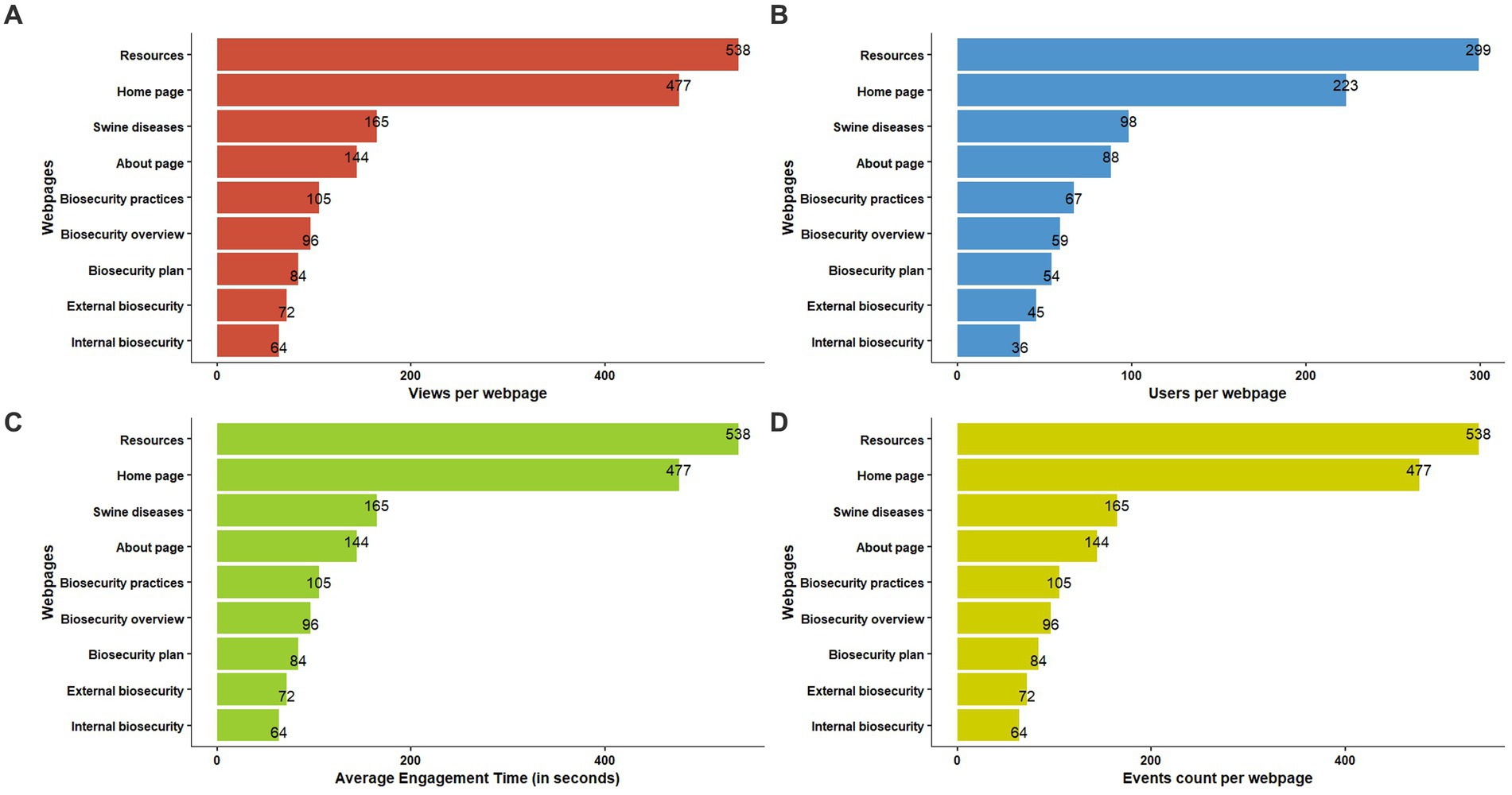
Figure 4. Google Analytics result for page-wise (A) views, (B) users, (C) average engagement time, and (D) event count.
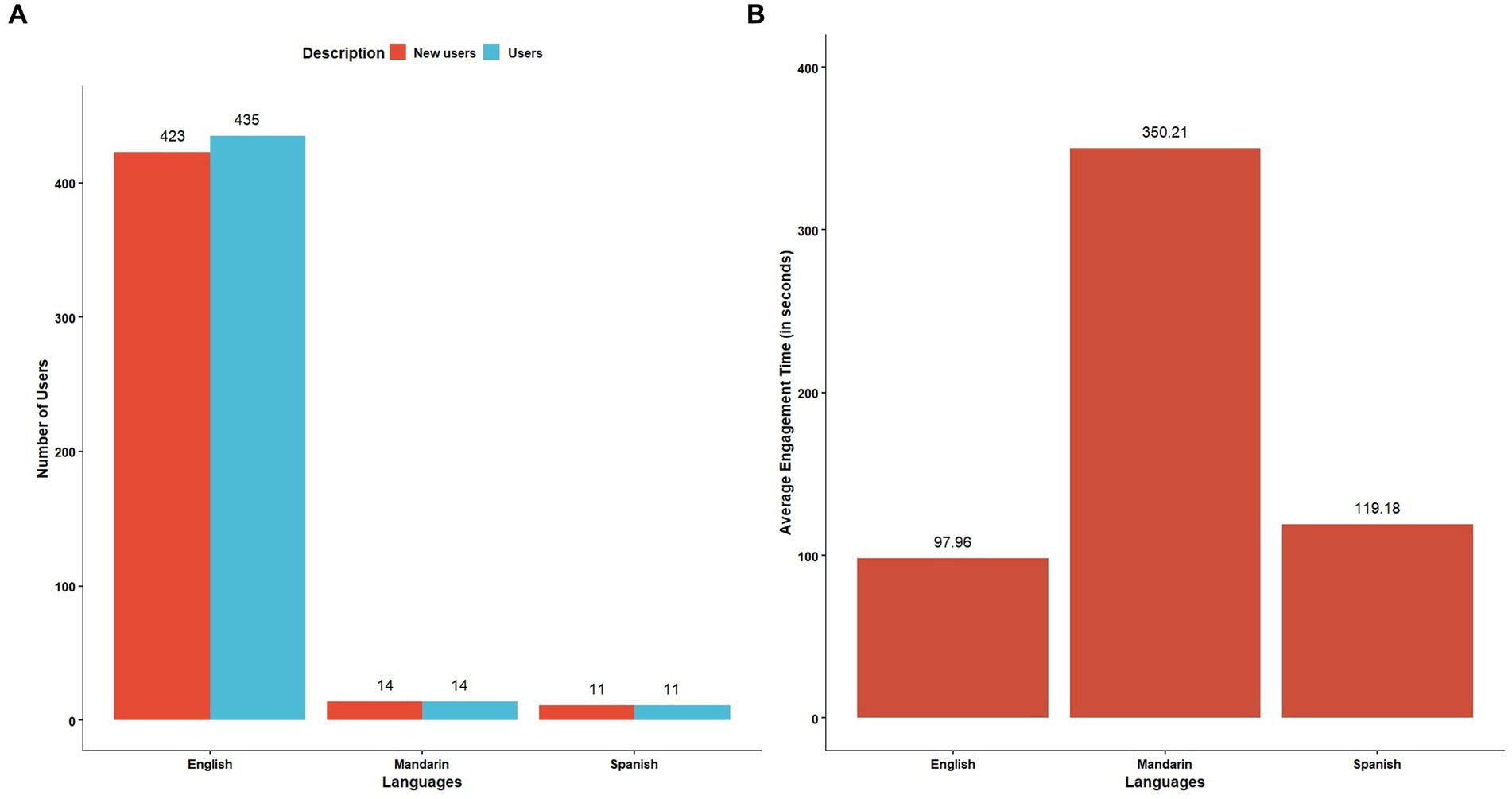
Figure 5. Google Analytics of the biosecurity website for language of users (A) user distribution (B) average engagement time.
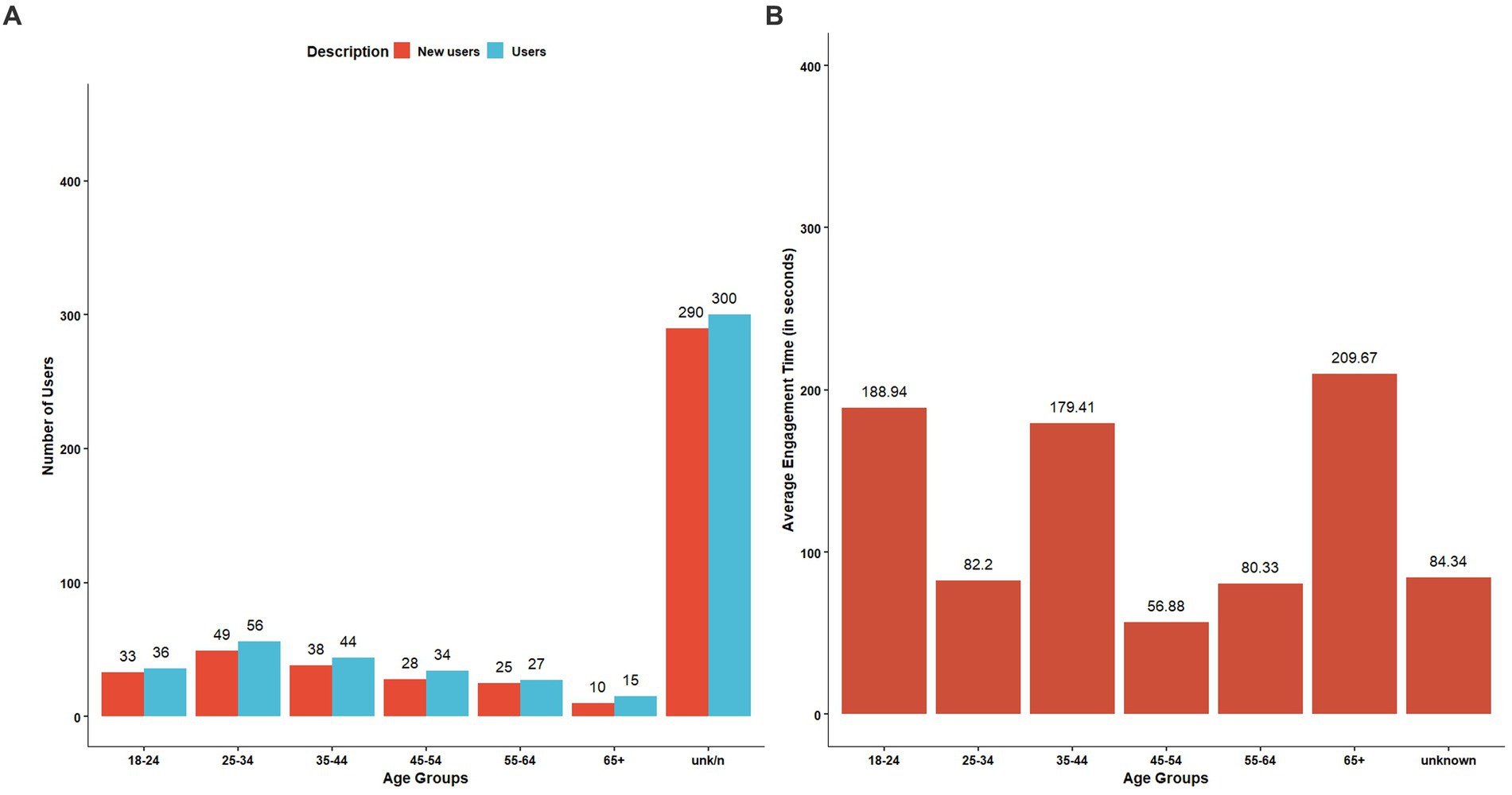
Figure 6. Google Analytics of the biosecurity website for user age groups (A) user distribution (B) average engagement time.
Sixty-six percent of persons who accessed the website used their desktop, while 33% used mobile. Forty-six percent of the users accessed the website through direct links, 35% accessed the website through referrals, and 10% did an organic search to access the website.
The biosecurity checklist infographic was viewed the most, with 58 users and 68 event counts (downloads), followed by entering the farm infographic and swine disease reporting infographic (Figure 7).
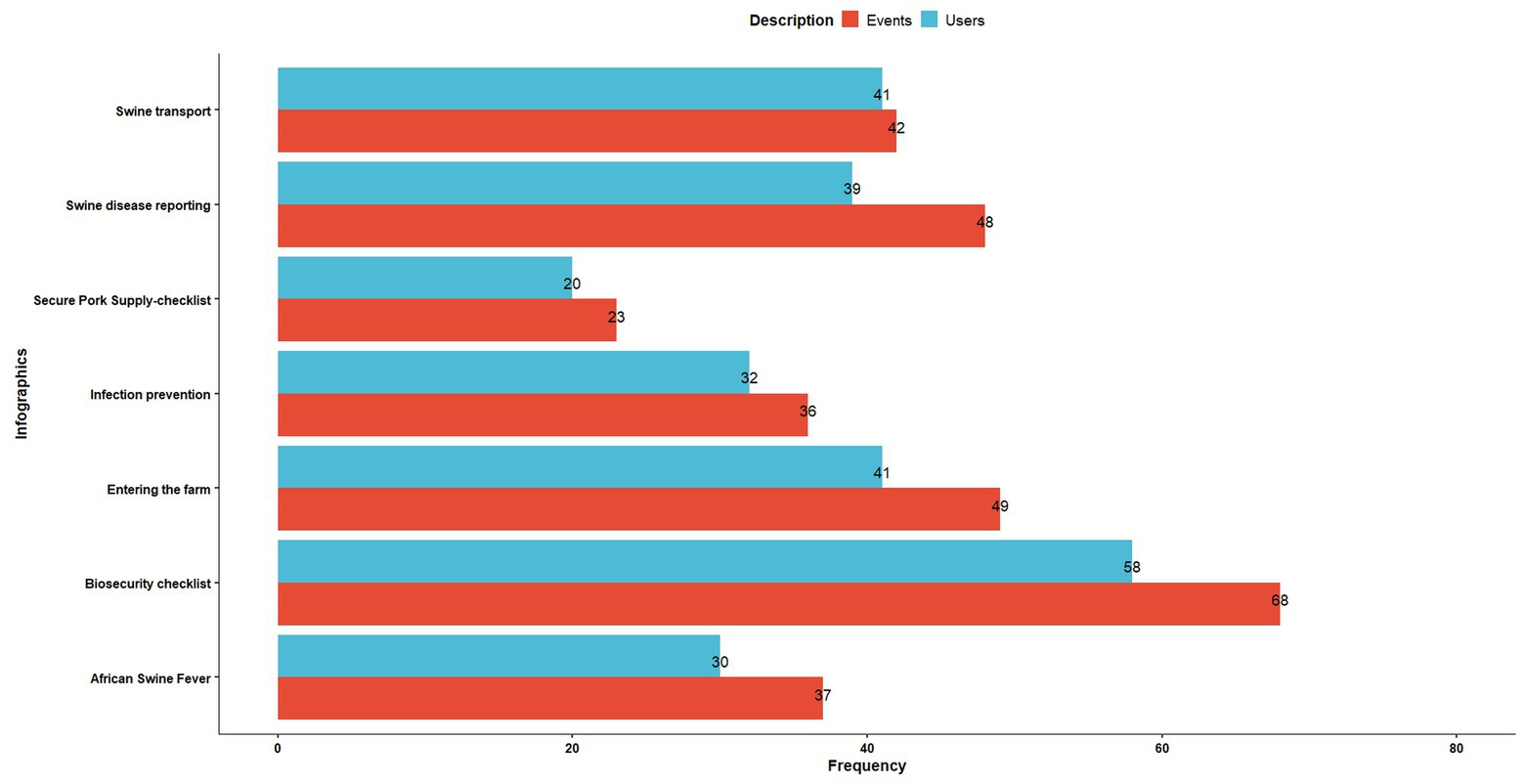
Figure 7. The frequency of total users and event counts (clicks/downloads) for each infographic on the resources page of the swine biosecurity website.
3.3.2. Modules of the swine biosecurity website
The biosecurity overview module had the maximum responses provided by users (n = 26), followed by the swine diseases module (n = 12), external biosecurity (n = 7), Secure Pork Supply module (n = 7), and internal biosecurity module (n = 6). The general biosecurity practices module quiz had no response in the 4 months of the study period. The “Test your knowledge” quiz questions for each module with the descriptions of total responses and correct and incorrect responses for each question can be found in Supplementary File 5.
We calculated the mean score for each module. The highest mean score of 4.83 was provided for the external biosecurity module, and the lowest mean score was 2.67 for the Secure Pork Supply plan module. The mean scores for the remaining modules were: Swine diseases (3.67), Biosecurity overview (3.62), and Internal biosecurity (3.83).
4. Discussion
This study evaluated Illinois swine producers’ and veterinarians’ biosecurity knowledge, perception, and practices through two independent cross-sectional online surveys. Based on the survey results and our team’s expertise in biosecurity, we created an educational website to inform and improve biosecurity knowledge and practices among swine producers and veterinarians. In addition, outreach efforts were tracked via Google Analytics to monitor website traffic, user demographics, and engagement time to enable us to monitor the website’s effectiveness and upgrade it if needed.
4.1. Survey of swine producers
Thirteen responders completed the swine producers’ survey, managing 82 farms across nine counties in Illinois and raising over 85,000 pigs. Understanding swine producers’ attitudes toward biosecurity and their foreign animal disease risk perception will help swine stakeholders to tailor the policies and programs to encourage sustainable adoption of disease prevention and control practices by the swine producers on their farms (47). Results of the perception-based questions in our survey revealed that more than half of swine producers did not perceive the risk of occurrence of a foreign animal disease outbreak in the US in the next 5 years. However, a qualitative assessment study from the US indicated that the likelihood of ASF entry into the US is high, mainly through legal or illegal imports (including bioterrorism) of swine products and by-products, animal feed, or genetic material (43). In the survey responses, 5 swine producers owning 14 swine farms believe the impact of foreign animal disease outbreak would last anywhere between 3 months to 12 months. Conversely, a disease modeling and forecasting study suggested that the impact of a foreign animal disease introduction in the US could last two to over 10 years, depending on the response efforts implemented to control its spread (44). These results suggest that the swine producers under-perceived the risk and impact of foreign animal disease outbreaks in the US. Given that perception is a core component in determining human behavior (19), the perception and attitude observed in the study results may negatively affect adopting biosecurity practices by swine producers.
Our study found that most swine farms followed the majority of the required biosecurity practices. Nevertheless, these results should not be generalized because a single producer (contractor/integrator) who owned a considerable proportion of farms (60 farms) and had a Secure Pork Supply plan implemented for his farms impacted the overall finding of this section. By removing the large integrator’s response, all the other producers’ biosecurity practices, such as isolating new incoming animals, disease monitoring, wild animal exclusion, bird control, requiring vehicles to be washed and disinfected before entry into the farm, showering before entering and exiting the farm, and having a separate entrance for waste-collecting vehicles were among the least commonly adopted biosecurity practices. Some of these biosecurity practices are expensive (e.g., setting up a showering facility) and are labor-intensive (e.g., disease monitoring), which are often limiting the implementation of these practices, especially for small-scale producers (35, 45). Before interpreting the results of the swine producer survey, some limitations need to be noted, particularly the low response rate, limiting the generalizability of our study results. The IPPA represents around 1,600 swine producers in Illinois, and as per USDA’s 2017 agriculture census data, there were 2,153 swine producers in Illinois. This, and the low response rate, limited the representativeness of our survey results. Future studies should incentivize producers who complete the survey (48) or use multiple survey modes or send multiple reminders at appropriate intervals to get a higher number of responses from swine producers (49).
4.2. Survey of swine veterinarians
Our study results revealed a positive perception of Illinois swine veterinarians towards biosecurity and its importance in infectious and foreign animal disease prevention and control. Unlike swine producers, swine veterinarians in Illinois had a higher foreign animal disease risk perception and considered the likelihood of a foreign animal disease outbreak in the US as highly likely. This is an encouraging finding as perceived risk is the driver of an individual’s risk-taking behavior (35, 50), suggesting that lower perceived risk might result in a lack of diligence in adopting and implementing biosecurity measures.
In our study, veterinarians considered people/workers the most common threat to farm biosecurity, which concurs with previous studies (3, 36). On the other hand, 29% of Illinois swine veterinarians thought it was “unlikely/very unlikely” for a veterinarian to transmit a disease from one animal to another, contrary to what previous studies suggested (24, 37, 51, 52). These findings are concerning as previous studies have shown that veterinarians’ perceptions can substantially influence their adoption of effective disease prevention practices (41). Moreover, despite awareness and having biosecurity training, many Illinois swine veterinarians did not always follow simple biosecurity practices like washing hands, changing disposable clothes and boots, and disinfecting examination tools between barns. The probable explanation for not following these practices could be a low perceived risk from these measures or their application being impractical in daily practice.
Previous studies have highlighted the role of swine veterinarians as a primary translator of information on biosecurity and related practices for swine producers (24, 42, 53, 54). In our study, swine veterinarians reported providing biosecurity advice to their clients during every consultation.
The survey results represent the opinion of an estimated 28% of the total swine veterinarians in Illinois. However, there might be non-response bias wherein the respondents’ opinions and practices might systematically differ from the non-respondents (55). Therefore, these results should be interpreted with caution.
4.3. Swine biosecurity educational website
We used the health-belief model as the conceptual framework for website development and chose a web-based educational tool as it serves as a medium to reach a large segment of swine producers and veterinarians. We developed a web-based educational tool and evaluated the outreach efforts using Google Analytics and content comprehension using self-assessing quizzes. Previous studies have used Google Analytics effectively as a web analytics tool for educational, commercial, and university websites (29–31). Seemingly, quizzes have become a popular way of assessing content comprehension and user interaction (56–58). For our study, Google Analytics helped examine the network behavioral patterns of the website users, and we deem our outreach effort successful as 473 new users accessed the site in the initial 4-month period of its launch. We expected a high access number of site visitors from Illinois due to our local outreach efforts, but we also received a high access number from Iowa, Minnesota, and North Carolina, the leading swine-producing states of the US, which is an encouraging finding. The average engagement time for the website was towards the lower end, suggesting future efforts should be made to improve the website content and enhance user experience to appeal to a larger audience. On a positive note, the website had users from around the world. However, a good proportion of our users were Mandarin and Spanish speakers. These findings were expected as China is a leading pork producer worldwide (59), which recently experienced a devastating ASF outbreak (60) that might increase pork producers’ awareness of infectious swine diseases and eagerness to learn more about effective disease prevention methods. The high proportion of Spanish-speaking visitors on the website can be explained by the data suggesting that over three-quarters of agricultural workers worldwide are Spanish speakers (61, 62). These results give us the future direction of expanding the website content in other languages.
The swine diseases page showed the maximum user engagement time, and the resources page had the top hit for views, user count, and event count. The resource page consisted of infographics related to reporting swine diseases, biosecurity protocols for entering a swine farm, transportation biosecurity, a biosecurity checklist for a swine farm, a description of the Secure Pork Supply plan, an information fact sheet on ASF, along with signs in downloadable format. Infographics are information snapshots consisting of the pictorial depiction of data in a concise manner (63), and they attract the user’s attention and enable better retention of information (64–66). Building over this concept, we designed these infographics to provide relevant information on swine diseases and effective biosecurity protocols concisely that the producers and veterinarians could use in their work settings to educate the farm employees. Infographics have proved to be a popular, effective, and feasible mode of information dissemination, and our study results on the resource page agree with the findings of previous studies on infographics’ effectiveness (65).
The study results of Google Analytics should be interpreted with caution for several reasons. The Google Analytics data has limitations because it does not record all website activities and only includes demographic information of users who made it public on their Google accounts. The reports show approximates of actual data and cannot identify the occupation of visitors. The access granted by Google Analytics and the anonymity of users limits the granularity of the data collected and is subjected to missing information. Moreover, we cannot ascertain but expect that most website visits came from swine stakeholders, veterinarians, and people interested in swine disease prevention and control as we shared our website on platforms with our targeted user base such as swine health and production-related websites, academic and professional social media platforms, the official website of the College of Veterinary Medicine, University of Illinois Urbana Champaign, and the ISVMA newsletter. Nevertheless, Google Analytics data gives us a good approximation of what is working on the website and what needs more attention, highlighting the areas that require re-evaluation and upgrade. Our study results suggest that we should allocate effort into designing more infographics and adding additional content to the swine diseases modules as these web pages attracted the most attention among users.
To facilitate learning and evaluate users’ understanding of the module content, we embedded short quizzes with automated marking at the end of each of the six modules. Periodic quizzes have enhanced learning experiences by reiterating important concepts, promoting active learning, and increasing learners’ engagement (56, 57, 67). In addition, automated feedback has been described as improving comprehension and providing a quick snapshot of users’ understanding of the subject (57). However, compared to the number of website users, the response rate for the quizzes embedded in the swine biosecurity modules was low. The plausible explanation for this low response rate for the quizzes could be the time constraints of users or a non-aligning interest in swine biosecurity. However, the users who did take an attempt on the quizzes performed well, indicating either prior background in swine biosecurity or an adequate understanding of the concepts provided through the modules after reading them.
5. Conclusion
Our study developed a novel methodology that utilized a stepwise method of assessing-developing-evaluating-improving. It assessed the knowledge and perception of swine producers and veterinarians on swine disease risk and biosecurity practices, developed an educational website to address the gaps identified through the surveys, and evaluated the outreach and efficacy of the website, with a final goal to improve foreign animal disease risk awareness and biosecurity practices of swine producers and veterinarians in Illinois, in the US, and worldwide. Understanding swine producers’ and veterinarians’ perceptions of biosecurity and its importance in disease control and prevention can help policymakers develop targeted programs and aid researchers and extension staff in tailoring their swine biosecurity educational efforts.
Data availability statement
The original contributions presented in the study are included in the article/Supplementary material, further inquiries can be directed to the corresponding author.
Ethics statement
The studies involving human participants were reviewed and approved by The Institutional Review Board (IRB) of the University of Illinois at Urbana Champaign (IRB #21974). The participants provided their written informed consent to participate in this study.
Author contributions
IA and CV: study design and writing—original draft. IA: data analysis and visualization. CV and CB: resources. IA, CV, and CB: writing—review and editing. CV: supervision and project administration. All authors contributed to the article and approved the submitted version.
Funding
This research was funded by Farm Bill funding through USDA Animal and Plant Health Inspection Service (APHIS) Veterinary Services (VS)’ National Animal Disease Preparedness and Response Program (NADPRP) 2020 (Award number: AP21VSSP0000C037).
Acknowledgments
We thank Illinois Pork Producers Association (IPPA) and Illinois State Veterinary Medical Association (ISVMA) for helping us with survey administration. We thank the Design Group@Vet Med – Justin Parker, Michael Linsner, and Nancy Oliver for helping us design the swine biosecurity website and infographics and Kathryn Rose Mosiman for editing the website content. We would like to thank Dijon Davis for setting up Google Analytics for the website. We would like to acknowledge the efforts of Christine A. Beuoy in advertising the biosecurity website. We also thank all Illinois veterinarians and swine producers who participated in this study.
Conflict of interest
The authors declare that the research was conducted in the absence of any commercial or financial relationships that could be construed as a potential conflict of interest.
Publisher’s note
All claims expressed in this article are solely those of the authors and do not necessarily represent those of their affiliated organizations, or those of the publisher, the editors and the reviewers. Any product that may be evaluated in this article, or claim that may be made by its manufacturer, is not guaranteed or endorsed by the publisher.
Supplementary material
The Supplementary material for this article can be found online at: https://www.frontiersin.org/articles/10.3389/fvets.2023.1167056/full#supplementary-material
References
1. USDA ERS-Hogs & Pork [Internet]. (Accessed November 14, 2022). Available at: https://www.ers.usda.gov/topics/animal-products/hogs-pork/
2. Filippitzi, ME, Brinch Kruse, A, Postma, M, Sarrazin, S, Maes, D, Alban, L, et al. Review of transmission routes of 24 infectious diseases preventable by biosecurity measures and comparison of the implementation of these measures in pig herds in six European countries. Transbound Emerg Dis. (2018) 65:381–98. doi: 10.1111/tbed.12758
3. Alarcón, LV, Allepuz, A, and Mateu, E. Biosecurity in pig farms: a review. Porc Health Manag. (2021) 7:5. doi: 10.1186/s40813-020-00181-z
4. USDA-National Agricultural Statistics Service-Census of Agriculture [Internet]. (Accessed November 14, 2022). Available at: https://www.nass.usda.gov/AgCensus/
6. Plain, RL, and Lawrence, JD. Swine production. Vet Clin Food Anim Pract. (2003) 19:319–37. doi: 10.1016/S0749-0720(03)00025-2
7. Cook, H, and Schulz, L. The Illinois pork industry 2021: Current structure and economic importance, vol. 9. [Internet]. (Accessed November 15, 2022). Available at: https://nppc.org/wp-content/uploads/2022/07/Illinois_.pdf
8. Black, NJ, Moraes, LE, and Arruda, AG. Association between different types of within-farm worker movements and number of pigs weaned per sow in US swine farms. Prev Vet Med. (2021) 186:105207. doi: 10.1016/j.prevetmed.2020.105207
9. Passafaro, TL, Fernandes, AF, Valente, BD, Williams, NH, and Rosa, GJ. Network analysis of swine movements in a multi-site pig production system in Iowa, USA. Prev Vet Med. (2020) 174:104856. doi: 10.1016/j.prevetmed.2019.104856
10. Moon, SA, Ferdousi, T, Self, A, and Scoglio, CM. Estimation of swine movement network at farm level in the US from the census of agriculture data. Sci Rep. (2019) 9:1–14. doi: 10.1038/s41598-019-42616-w
11. Interpretable machine learning applied to on-farm biosecurity and porcine reproductive and respiratory syndrome virus - Sykes -2022- Transboundary and Emerging Diseases-Wiley Online Library [Internet]. (Accessed November 14, 2022). Available at: https://onlinelibrary.wiley.com/doi/10.1111/tbed.14369
12. Schulz, LL, and Tonsor, GT. Assessment of the economic impacts of porcine epidemic diarrhea virus in the United States. J Anim Sci. (2015) 93:5111–8. doi: 10.2527/jas.2015-9136
13. Herrera-Ibatá, DM, Martínez-López, B, Quijada, D, Burton, K, and Mur, L. Quantitative approach for the risk assessment of African swine fever and classical swine fever introduction into the United States through legal imports of pigs and swine products. Plo S One. (2017) 12:e0182850. doi: 10.1371/journal.pone.0182850
14. Rock, DL. Challenges for African swine fever vaccine development—“… perhaps the end of the beginning.”. Vet Microbiol. (2017) 206:52–8. doi: 10.1016/j.vetmic.2016.10.003
15. Moore, C. Biosecurity and minimal disease herds. Vet Clin North Am Food Anim Pract. (1992) 8:461–74. doi: 10.1016/S0749-0720(15)30698-8
16. Kuster, K, Cousin, ME, Jemmi, T, Schüpbach-Regula, G, and Magouras, I. Expert opinion on the perceived effectiveness and importance of on-farm biosecurity measures for cattle and swine farms in Switzerland. PLoS One. (2015) 10:e0144533. doi: 10.1371/journal.pone.0144533
17. Jurado, C, Martínez-Avilés, M, De La Torre, A, Štukelj, M, de Carvalho Ferreira, HC, Cerioli, M, et al. Relevant measures to prevent the spread of African swine fever in the European Union domestic pig sector. Front Vet Sci. (2018) 5:77. doi: 10.3389/fvets.2018.00077
18. Casal, J, de Manuel, A, Mateu, E, and Martin, M. Biosecurity measures on swine farms in Spain: perceptions by farmers and their relationship to current on-farm measures. Prev Vet Med. (2007) 82:138–50. doi: 10.1016/j.prevetmed.2007.05.012
19. Adebowale, OO, Adeyemo, FA, Bankole, N, Olasoju, M, Adesokan, HK, Fasanmi, O, et al. Farmers’ perceptions and drivers of antimicrobial use and abuse in commercial pig production, Ogun state, Nigeria. Int J Environ Res Public Health. (2020) 17:3579. doi: 10.3390/ijerph17103579
20. Alarcon, P, Wieland, B, Mateus, ALP, and Dewberry, C. Pig farmers’ perceptions, attitudes, influences and management of information in the decision-making process for disease control. Spec Issue SVEPM 2013 – Truly Glob Conf. (2014) 116:223–42. doi: 10.1016/j.prevetmed.2013.08.004
21. Heath, G, Cooke, R, and Cameron, E. A theory-based approach for developing interventions to change patient Behaviours: a medication adherence example from paediatric secondary care. Healthc Basel Switz. (2015) 3:1228–42. doi: 10.3390/healthcare3041228
22. Ajzen, I. The theory of planned behavior. Organ Behav Hum Decis Process. (1991) 50:179–211. doi: 10.1016/0749-5978(91)90020-T
23. Theory of Planned Behavior|Springer Link [Internet]. (Accessed January 19, 2023). Available at: https://link.springer.com/referenceworkentry/10.1007/978-3-319-28099-8_1191-1
24. Renault, V, Humblet, MF, Moons, V, Bosquet, G, Gauthier, B, Cebrian, LM, et al. Rural veterinarian’s perception and practices in terms of biosecurity across three European countries. Transbound Emerg Dis. (2018) 65:e183–93. doi: 10.1111/tbed.12719
25. Kim, Y, Yang, M, Goyal, SM, Cheeran, MCJ, and Torremorell, M. Evaluation of biosecurity measures to prevent indirect transmission of porcine epidemic diarrhea virus. BMC Vet Res. (2017) 13:89. doi: 10.1186/s12917-017-1017-4
26. McKimm, J, Jollie, C, and Cantillon, P. Web based learning. BMJ. (2003) 326:870–3. doi: 10.1136/bmj.326.7394.870
27. Extension online: utilizing technology to enhance educational outreach [internet]. The Journal of Extension (JOE). (Accessed January 17, 2023). Available at: https://archives.joe.org/joe/2012october/tt4.php
28. Robles, ACM. The use of educational web tools: An innovative technique in teacher education courses. Int J Mod Educ Comput Sci. (2013) 5:34–40. doi: 10.5815/ijmecs.2013.02.05
29. Fang, W. Using Google analytics for improving library website content and design: a case study. (2007). Library Philosophy and Practice (e-journal). 121. Available at: https://digitalcommons.unl.edu/libphilprac/121
30. Betty, P. Assessing homegrown library collections: using Google analytics to track use of screencasts and flash-based learning objects. J Electron Resour Librariansh. (2009) 21:75–92. doi: 10.1080/19411260902858631
31. Chen, SC, Tsao, TCY, Lue, KH, and Tsai, Y. Google analytics of a pilot study to characterize the visitor website statistics and implicate for enrollment strategies in medical university. BMC Med Educ. (2020) 20:483. doi: 10.1186/s12909-020-02373-1
32. Google analytics of a pilot mass and social media campaign targeting Hispanics about living kidney donation – science direct [internet]. (Accessed January 17, 2023). Available at: https://www.sciencedirect.com/science/article/pii/S2214782916300203?via%3Dihub
33. Ribbens, S, Dewulf, J, Koenen, F, Mintiens, K, de Sadeleer, L, de Kruif, A, et al. A survey on biosecurity and management practices in Belgian pig herds. Prev Vet Med. (2008) 83:228–41. doi: 10.1016/j.prevetmed.2007.07.009
34. da Costa, MR, Gasa, J, JAC, D, Postma, M, Dewulf, J, Mccutcheon, G, et al. Using the Biocheck.UGentTM scoring tool in Irish farrow-to-finish pig farms: assessing biosecurity and its relation to productive performance. Porc Health Manag. (2019) 5:4. doi: 10.1186/s40813-018-0113-6
35. Pudenz, CC, Schulz, LL, and Tonsor, GT. Adoption of secure pork supply plan biosecurity by U.S. swine producers. Front Vet Sci. (2019) 6:146. doi: 10.3389/fvets.2019.00146
36. Simon-Grife, M, Martin-Valls, GE, Vilar-Ares, MJ, Garcia-Bocanegra, I, Martin, M, Mateu, E, et al. Biosecurity practices in Spanish pig herds: perceptions of farmers and veterinarians of the most important biosecurity measures. Prev Vet Med. (2013) 110:223–31. doi: 10.1016/j.prevetmed.2012.11.028
37. Noremark, M, and Sternberg-Lewerin, S. On-farm biosecurity as perceived by professionals visiting Swedish farms. Acta Vet Scand. (2014) 56:28. doi: 10.1186/1751-0147-56-28
38. Alarcon, LV, Monterubbianesi, M, Perelman, S, Sanguinetti, HR, Perfumo, CJ, Mateu, E, et al. Biosecurity assessment of Argentinian pig farms. Prev Vet Med. (2019) 170:104637. doi: 10.1016/j.prevetmed.2019.02.012
39. Verkola, M, Järvelä, T, Järvinen, A, Jokelainen, P, Virtala, AM, Kinnunen, PM, et al. Infection prevention and control practices of ambulatory veterinarians: a questionnaire study in Finland. Vet Med Sci. (2021) 7:1059–70. doi: 10.1002/vms3.464
40. Venkat, H, Yaglom, HD, and Adams, L. Knowledge, attitudes, and practices relevant to zoonotic disease reporting and infection prevention practices among veterinarians - Arizona, 2015. Prev Vet Med. (2019) 169:104711. doi: 10.1016/j.prevetmed.2019.104711
41. Dowd, K, Taylor, M, Toribio, JALML, Hooker, C, and Dhand, NK. Zoonotic disease risk perceptions and infection control practices of Australian veterinarians: call for change in work culture. Prev Vet Med. (2013) 111:17–24. doi: 10.1016/j.prevetmed.2013.04.002
42. Gunn, GJ, Heffernan, C, Hall, M, McLeod, A, and Hovi, M. Measuring and comparing constraints to improved biosecurity amongst GB farmers, veterinarians and the auxiliary industries. Peeler E, Alban L, Editors. Prev Vet Med. (2008) 84:310–23. doi: 10.1016/j.prevetmed.2007.12.003
43. Brown, VR, Miller, RS, McKee, SC, Ernst, KH, Didero, NM, Maison, RM, et al. Risks of introduction and economic consequences associated with African swine fever, classical swine fever and foot-and-mouth disease: a review of the literature. Transbound Emerg Dis. (2021) 68:1910–65. doi: 10.1111/tbed.13919
44. Carriquiry, M, Elobeid, A, Swenson, D, and Hayes, D. Impacts of African swine fever in Iowa and the United States. (2020). Working paper 20-WP 600. Center for Agricultural and Rural Development, Iowa State University, Ames, Iowa, United States of America.
45. Schembri, N, Hernandez-Jover, M, Toribio, JALML, and Holyoake, PK. On-farm characteristics and biosecurity protocols for small-scale swine producers in eastern Australia. Prev Vet Med. (2015) 118:104–16. doi: 10.1016/j.prevetmed.2014.11.008
46. SPS Plan [Internet]. Secure Pork Supply Plan. (Accessed January 30, 2023). Available at: https://www.securepork.org/
47. Trujillo-Barrera, A, Pennings, JME, and Hofenk, D. Understanding producers’ motives for adopting sustainable practices: the role of expected rewards, risk perception and risk tolerance. Eur Rev Agric Econ. (2016) 43:359–82. doi: 10.1093/erae/jbv038
48. Smith, MG, Witte, M, Rocha, S, and Basner, M. Effectiveness of incentives and follow-up on increasing survey response rates and participation in field studies. BMC Med Res Methodol. (2019) 19:230. doi: 10.1186/s12874-019-0868-8
49. Improving the response rate and quality in Web-based surveys through the personalization and frequency of reminder mailings|SpringerLink [Internet]. (Accessed February 13, 2023). Available at: https://link.springer.com/article/10.1007/s11135-009-9256-5
50. Bucini, G, Merrill, SC, Clark, E, Moegenburg, SM, Zia, A, Koliba, CJ, et al. Risk attitudes affect livestock biosecurity decisions with ramifications for disease control in a simulated production system. Front Vet Sci. (2019) 6:196. doi: 10.3389/fvets.2019.00196
51. Noremark, M, Frossling, J, and Lewerin, SS. Application of routines that contribute to on-farm biosecurity as reported by Swedish livestock farmers. Transbound Emerg Dis. (2010) 57:225–36. doi: 10.1111/j.1865-1682.2010.01140.x
52. Mee, JF, Geraghty, T, O’Neill, R, and More, SJ. Bioexclusion of diseases from dairy and beef farms: risks of introducing infectious agents and risk reduction strategies. Vet J. (2012) 194:143–50. doi: 10.1016/j.tvjl.2012.07.001
53. Heffernan, C, Nielsen, L, Thomson, K, and Gunn, G. An exploration of the drivers to bio-security collective action among a sample of UK cattle and sheep farmers. Prev Vet Med. (2008) 87:358–72. doi: 10.1016/j.prevetmed.2008.05.007
54. Sayers, RG, Sayers, GP, Mee, JF, Good, M, Bermingham, ML, Grant, J, et al. Implementing biosecurity measures on dairy farms in Ireland. Vet J. (2013) 197:259–67. doi: 10.1016/j.tvjl.2012.11.017
55. Berg, N. Non-Response Bias. K Kempf-Leonard, Ed. Encyclopedia of social measurement [internet]. New York: Elsevier; (2005) (Accessed March 31, 2023). 865–873
56. Cook, BR, and Babon, A. Active learning through online quizzes: better learning and less (busy) work. J Geogr High Educ. (2017) 41:24–38. doi: 10.1080/03098265.2016.1185772
57. Gamage, SHPW, Ayres, JR, Behrend, MB, and Smith, EJ. Optimising Moodle quizzes for online assessments. Int J STEM Educ. (2019) 6:27. doi: 10.1186/s40594-019-0181-4
58. Jaeger, M, and Adair, D. Time pressure in scenario-based online construction safety quizzes and its effect on students’ performance. Eur J Eng Educ. (2017) 42:241–51. doi: 10.1080/03043797.2016.1153042
59. Zhao, Q, Dupas, MC, Axelsson, C, Artois, J, Robinson, TP, and Gilbert, M. Distribution and intensification of pig production in China 2007–2017. Environ Res Lett. (2022) 17:124001. doi: 10.1088/1748-9326/aca16b
60. Tao, D, Sun, D, Liu, Y, Wei, S, Yang, Z, An, T, et al. One year of African swine fever outbreak in China. Acta Trop. (2020) 211:105602. doi: 10.1016/j.actatropica.2020.105602
61. NAWS-Research-Report-13.pdf [Internet]. (Accessed January 27, 2023). Available at: https://www.dol.gov/sites/dolgov/files/OASP/legacy/files/NAWS-Research-Report-13.pdf
62. Simpson, H, Edwards-Callaway, LN, Cramer, MC, Roman-Muniz, IN, Stallones, L, Thompson, S, et al. Preliminary study exploring caretaker perspectives of euthanasia on swine operations. Animals. (2020) 10:2296. doi: 10.3390/ani10122296
63. Ksenija, DA, Katarina, S, Marijana, T, Marijana, Š, Milan, O, and Tijana, S, et al. Community management in SERBIA and FACEBOOK influence on SERBIAN society
64. Ozdamlı, F, Kocakoyun, S, Sahin, T, and Akdag, S. Statistical reasoning of impact of infographics on education. Procedia Comput Sci. (2016) 102:370–7. doi: 10.1016/j.procs.2016.09.414
65. Romano, A. The effectiveness of infographics and how it is applied to communicate the effects of factory farming. Honors Coll Theses [Internet]. (2019); Available at: https://digitalcommons.pace.edu/honorscollege_theses/229
66. (PDF) The Use of Infographics as a Tool for Facilitating Learning [Internet]. (Accessed January 27, 2023). Available at: https://www.researchgate.net/publication/284180153_The_Use_of_Infographics_as_a_Tool_for_Facilitating_Learning
Keywords: United States, Illinois, swine, biosecurity, veterinarians, farmers, foreign animal disease, Google analytics
Citation: Agrawal I, Bromfield C and Varga C (2023) Assessing and improving on-farm biosecurity knowledge and practices among swine producers and veterinarians through online surveys and an educational website in Illinois, United States. Front. Vet. Sci. 10:1167056. doi: 10.3389/fvets.2023.1167056
Edited by:
Marta Hernandez-Jover, Charles Sturt University, AustraliaReviewed by:
Dustin L. Pendell, Kansas State University, United StatesGustavo Machado, North Carolina State University, United States
Copyright © 2023 Agrawal, Bromfield and Varga. This is an open-access article distributed under the terms of the Creative Commons Attribution License (CC BY). The use, distribution or reproduction in other forums is permitted, provided the original author(s) and the copyright owner(s) are credited and that the original publication in this journal is cited, in accordance with accepted academic practice. No use, distribution or reproduction is permitted which does not comply with these terms.
*Correspondence: Csaba Varga, Y3ZhcmdhQGlsbGlub2lzLmVkdQ==
 Isha Agrawal
Isha Agrawal Corinne Bromfield
Corinne Bromfield Csaba Varga
Csaba Varga